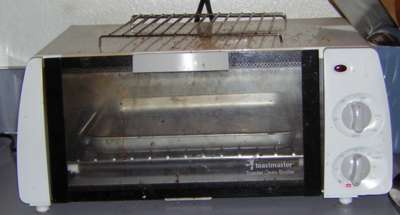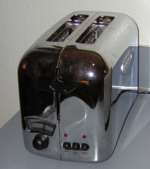the Tragedy of the Toaster

510 lab 1
Lillie Kittredge

The design was made with pretty obvious choices: you need to control the temperature, and you need to control how long it cooks (represented on some toasters by how dark you want your toast). And so, there are two knobs, one for temperature, and one for how long it cooks. In this presentation, I'll gripe about why the design is bad, then say why I suspect it was designed this way.

The ticking noise and ding provide auditory feedback on the state of the oven, which may be why they were included (it may also just be difficult to mask the sound of the ticking). Though I appreciate some manner of alert, I prefer the sound of a spring being tripped, such as an upright toaster makes by its design. I would argue that there is no need for the ticking sound, since no danger befalls the user by it slipping their mind that there's toast in the oven, as the toaster will turn itself off soon enough.
I would speculate that the arc drawn on the dial from 0 to about 7 minutes is meant to indicate the range appropriate for toast. If so, it was pretty clearly just a guess on the part of the designers, since in my experiments, turning the knob to the highest end of the arc results in rather blacker, smokier toast than most users prefer.
The course timing granularity in the toast range is due to the fact that the dial goes all the way up to 30 minutes. It would have benefited the designers to think harder about how long their users tend to want to put things in the toaster oven. When I use the toaster oven, it's generally for toasting things that have to be horizontal, for instance, those involving cheese. These items only need to be cooked for the same amount of time that bread needs to be toasted for. I suspect that most casual toaster-oven users have similar behavior patterns. (Searching for toaster ovens on the Internet for purposes of comparison, I find a surprising number of "professional" styles. Do restaurants use them for some purposes? Or is the "professional" toaster just to lure conspicuous-consumption buyers? I am perplexed.) Some users certainly would want longer times, for example, users without access to a full-sized oven. What percentage of the expected market for this product were those users? Did the designers consider who was likely to be using their product?
A meta-problem of this kind of timer for toast is that it has to be set each time you want toast. With upright toasters, one can usually set a dial to the desired darkness, and press a button to initiate toasting which does not interfere with the dial. In that design, the amount of toasting can be set as a state variable, allowing the same degree of toastedness to be reliably recreated. In this design, it's hit-or-miss with each piece of toast, not to mention that dealing with a dial is a lot more taxing first thing in the morning than pressing a button or lever would be. On the other hand, this design provides something that the dial-and-button design does not: constant visual feedback on toast timer progress. This would be more useful if using the oven function and cooking something which needed a particular number of minutes. However, I would argue that visual feedback on progress towards doneness is provided already by the clear door and the user's own understanding of how dark they want their toast.
It covers a standard range of temperatures for ovens, ending in "broil", which is the state where maximum power flows to only the top pair of electrical elements. This is a convention of regular ovens, which is probably why it was chosen (along with the lack of other options). Some visual distinction between regular oven behavior and broiling behavior would be good - as it is, the only visual feedback that you've really got it on broil is to note that only the top set of elements is glowing. This is a factor that differs slightly in the design of the temperature knob versus the timer knob. Where the timer offered the "stay on" state at the end of the spectrum, it left off the tic mark that it had used for the other times, giving a subtle visual clue that "stay on" was somehow different in kind from "30". The inclusion of the tic mark on "broil" makes it seem to still be part of the spectrum, that "broil" should just mean "500". I suspect that this was not a conscious design decision, just the effect of a not particularly conscientious design process.
An unintentional useful aspect of the toaster is that if one leaves the pan and little rack on top of the oven when not in use, it provides something to put toast on while buttering it, without water condensing under the toast and making that side soggy. (Some of us are picky about our toast.)
 We got a new toaster for actual bread-toasting. Not only does it have much finer-grained toast color controls, but it's shiny. It includes a "cancel" button to safely abort toasting before the time's up, and includes "defrost" and "bagel" buttons, each with their own light to indicate that option has been selected.
We got a new toaster for actual bread-toasting. Not only does it have much finer-grained toast color controls, but it's shiny. It includes a "cancel" button to safely abort toasting before the time's up, and includes "defrost" and "bagel" buttons, each with their own light to indicate that option has been selected.